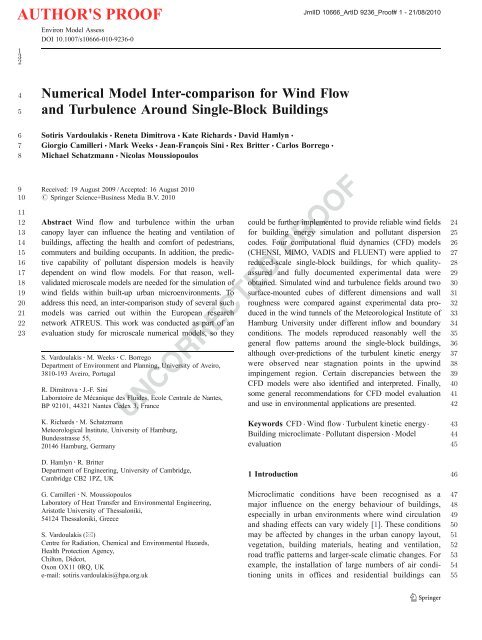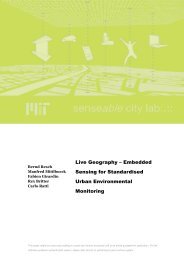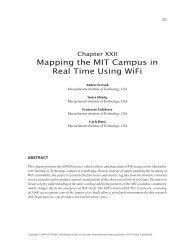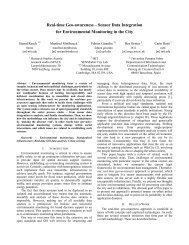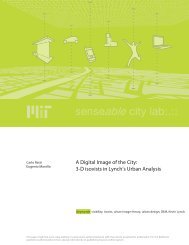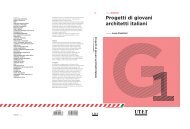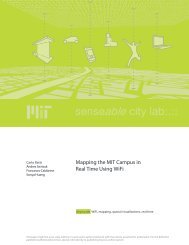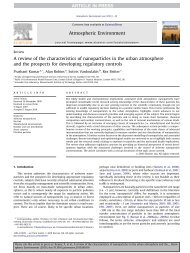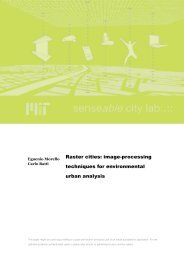AUTHOR'S PROOF132Environ Model AssessDOI 10.1007/s10666-010-9236-0JrnlID 10666_ArtID 9236_Proof# 1 - 21/08/20104 Numerical Model Inter-comparison for Wind Flow5 and Turbulence Around Single-Block Buildings6 Sotiris Vardoulakis & Reneta Dimitrova & Kate Richards & David Hamlyn &7 Giorgio Camilleri & Mark Weeks & Jean-François Sini & Rex Britter & Carlos Borrego &8 Michael Schatzmann & Nicolas Moussiopoulos9 Received: 19 August 2009 /Accepted: 16 August 201010 # Springer Science+Business Media B.V. 20101112 Abstract Wind flow and turbulence within the urban13 canopy layer can influence the heating and ventilation of14 buildings, affecting the health and comfort of pedestrians,15 commuters and building occupants. In addition, the predic-16 tive capability of pollutant dispersion models is heavily17 dependent on wind flow models. For that reason, well-18 validated microscale models are needed for the simulation of19 wind fields within built-up urban microenvironments. To20 address this need, an inter-comparison study of several such21 models was carried out within the European research22 network ATREUS. This work was conducted as part of an23 evaluation study for microscale numerical models, so theyS. Vardoulakis : M. Weeks : C. BorregoDepartment of Environment and Planning, University of Aveiro,3810-193 Aveiro, PortugalR. Dimitrova : J.-F. SiniLaboratoire de Mécanique des Fluides, Ecole Centrale de Nantes,BP 92101, 44321 Nantes Cedex 3, FranceK. Richards : M. SchatzmannMeteorological Institute, University of Hamburg,Bundesstrasse 55,20146 Hamburg, Germanycould be further implemented to provide reliable wind fieldsfor building energy simulation and pollutant dispersioncodes. Four computational fluid dynamics (CFD) models(CHENSI, MIMO, VADIS and FLUENT) were applied toreduced-scale single-block buildings, for which qualityassuredand fully documented experimental data wereobtained. Simulated wind and turbulence fields around twosurface-mounted cubes of different dimensions and wallroughness were compared against experimental data producedin the wind tunnels of the Meteorological Institute ofHamburg University under different inflow and boundaryconditions. The models reproduced reasonably well thegeneral flow patterns around the single-block buildings,although over-predictions of the turbulent kinetic energywere observed near stagnation points in the upwindimpingement region. Certain discrepancies between theCFD models were also identified and interpreted. Finally,some general recommendations for CFD model evaluationand use in environmental applications are presented.UNCORRECTED PROOFKeywords CFD . Wind flow. Turbulent kinetic energy.Building microclimate . Pollutant dispersion . Modelevaluation24252627282930313233343536373839404142434445D. Hamlyn : R. BritterDepartment of Engineering, University of Cambridge,Cambridge CB2 1PZ, UKG. Camilleri : N. MoussiopoulosLaboratory of Heat Transfer and Environmental Engineering,Aristotle University of Thessaloniki,54124 Thessaloniki, GreeceS. Vardoulakis (*)Centre for Radiation, Chemical and Environmental Hazards,Health Protection Agency,Chilton, Didcot,Oxon OX11 0RQ, UKe-mail: sotiris.vardoulakis@hpa.org.uk1 IntroductionMicroclimatic conditions have been recognised as amajor influence on the energy behaviour of buildings,especially in urban environments where wind circulationand shading effects can vary widely [1]. These conditionsmay be affected by changes in the urban canopy layout,vegetation, building materials, heating and ventilation,road traffic patterns and larger-scale climatic changes. Forexample, the installation of large numbers of air conditioningunits in offices and residential buildings can46474849505152535455
AUTHOR'S PROOFJrnlID 10666_ArtID 9236_Proof# 1 - 21/08/2010S. Vardoulakis et al.56 increase heat emissions within street canyons, exacerbat-57 ing the urban heat island effect [2]. Microclimatic58 condition also affects pollutant dispersion within the59 urban environment and entrainment into buildings [3].60 Numerical computational fluid dynamic (CFD) models61 can help simulate different microclimatic scenarios and62 establish their impact on the energy behaviour of buildings,63 as well as on pollutant dispersion and entrainment.64 Individual CFD models have been commonly used to study65 wind, temperature and air pollution fields in outdoor urban66 environments [4–7], industrial sites [8], public transport67 facilities [9], indoor building environments [9–12] and68 around the human body [13]. In these applications, the69 Reynolds Averaged Navier–Stokes (RANS) modelling70 approach has been widely used [14, 15], although more71 advanced modelling methods such as Large Eddy Simu-72 lations (LES) are becoming increasingly popular [16, 17].73 Several attempts have been made to simulate surface-74 mounted cubes, either as isolated structures or a periodic75 array, using CFD models [18–20]. Despite their simplicity,76 isolated surface-mounted cubes within a well-developed77 wind flow can reproduce the most salient features of wind78 flow around real buildings, i.e. sharp pressure gradients,79 multiple separation and re-attachment regions, as shown by80 wind tunnel flow visualisation experiments [21]. For this81 reason, they have been commonly used as a benchmark for82 the evaluation of CFD models [22]. More complex83 geometries of buildings with varying aspect ratios (i.e.84 height-to-width) or roof shapes, as well as arrays of85 different-sized and different-shaped buildings, have also86 been used for model evaluation [23, 24].87 It has been demonstrated that similar numerical models,88 based on the same physical principles and mathematical89 formulation and using the same input and boundary conditions,90 can give significantly different results [24, 25]. This is often91 due to differences in coding, parameterisation, grid resolution92 and input data pre-processing but also due to different levels93 of the user’s expertise. For that reason, it is essential that94 commercially available as well as research-oriented numerical95 models are comprehensively evaluated using quality-assured96 and fully documented experimental datasets.97 Microscale numerical models have often been validated98 against experimental reduced-scale wind tunnel data [26] or99 less commonly against full-scale field data [27, 28]. The100 two most common reduced-scale modelling techniques are101 wind tunnel and water tank modelling, both based on the102 similarity principle (i.e. original full-scale flow conditions103 reproduced by reducing the geometrical scale of structures104 and adjusting reference parameters such as wind velocity).105 Wind tunnel experiments have been more commonly used106 to simulate atmospheric flows [29], although water tank107 experiments have also been used in the past [18]. In108 addition to reduced-scale setups, full-scale experimentsaround real buildings have been used for numerical modelvalidation [30]. Although good agreement is generallyexpected between reduced- and full-scale modelling results,certain discrepancies in the wind flow field near the roofand leeward side of buildings may be observed, dependingon approach flow conditions and scale [31, 32].The present study explores the capability of four CFDcodes to reproduce experimental wind flows around isolatedsingle-block buildings, using the commonly used steadystateRANS approach. Two isolated cubes, representing thesimplest structural unit of urban canopies, mounted in windtunnels were used to test the selected models and developcertain recommendations for numerical model use and intercomparison.This study has been carried out within theEuropean research network Advanced Tools for RationalEnergy Use towards Sustainability (ATREUS with emphasison microclimatic issues in urban applications), as part of anevaluation study for these models so they could be furtherimplemented to provide boundary condition data for buildingsimulation codes. Put into context, the overall objective ofATREUS was to study the wind–building interactions, takinginto account local meteorological and microclimatic conditionsthrough the synthesis of climate models on all scales, i.e.from mesoscale to microscale to the building environment[33].2 Methodology2.1 Experimental DatasetsIn the present study, two quality-assured and fully documentedexperimental datasets produced in the wind tunnelsof the Meteorological Institute of Hamburg University,Germany, were used for the evaluation of the numericalmodels. The experimental datasets included wind andturbulence fields around two surface-mounted cubes ofdifferent dimensions and wall roughness:UNCORRECTED PROOF(a) The CEDVAL cube (0.125 m×0.125 m×0.125 m)which was studied in the BLASIUS wind tunnel. Thisis a conventional-type boundary layer wind tunnelwith a 15-m-long and 1-m-high test section and a 4-mwideturn table [23](b) The ATREUS cube (0.190 m×0.190 m×0.190 m)which was built for the purpose of this study andplaced in a multi-layer stratified wind tunnel. Thistunnel is of closed circuit type with its returnsection made up of nine horizontal ducts ofrectangular shape. The height and width of theircross sections are 0.12 and 2.3 m, respectively. Theusable length of the test section of the wind tunnelis about 4.5 m [34, 35]. More information about the109110111112113114115116117118119120121122123124125126127128129130131132133134135136137138139140141142143144145146147148149150151152153154155156


